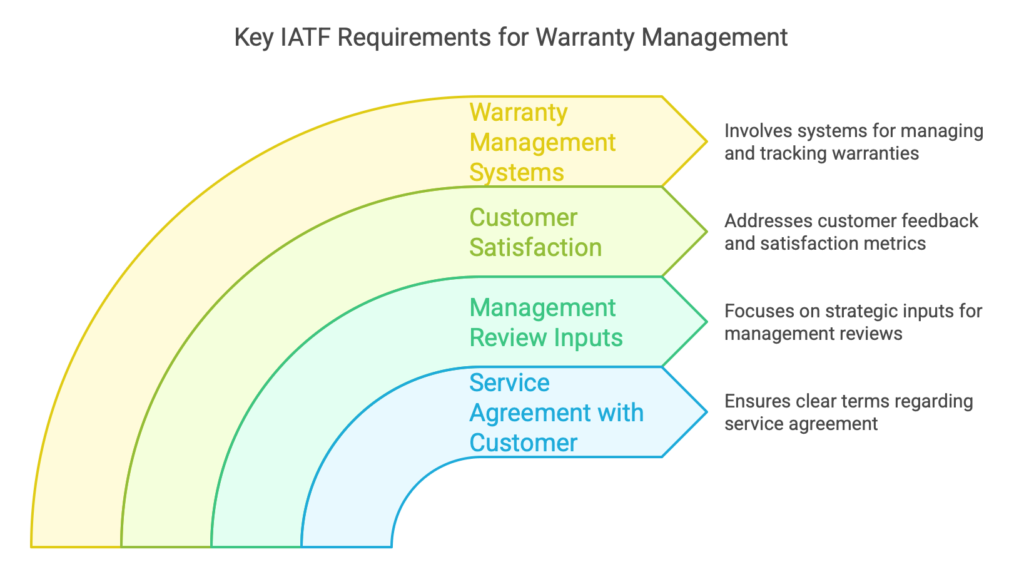IATF requirements emphasize product quality not only from the perspective of complaints originating at the customer’s plant but also in terms of the performance of vehicles used by end customers under warranty.
For this reason, anyone within an organization handling warranty returns must identify the key IATF requirements relevant to this area. These include:
- 8.5.5.2 Service Agreement with Customer
- 9.3.2.1 Management Review Inputs – Supplemental
- 9.1.2.1 Customer Satisfaction – Supplemental
- 10.2.5 Warranty Management Systems

8.5.5.2 Service Agreement with Customer
If a service agreement exists with the customer, the organization must ensure that service centers comply with the stipulated requirements. Additionally, it is the organization’s responsibility to train service personnel, if necessary.
A common aspect of such agreements is the diagnostic procedure, which outlines the diagnostic activities service stations must perform using the appropriate tools and equipment. This procedure helps avoid unnecessary component replacements, especially for parts that, upon analysis, are found to be functioning correctly.
These parts are classified as No Trouble Found (NTF). NTF incidents incur warranty costs that are typically shared equally between the client and the organization (50/50). By implementing an effective diagnostic procedure, organizations can reduce the frequency of NTF incidents, which directly lowers warranty costs.
9.3.2.1 Management Review Inputs – Supplemental
Warranty returns must be included in management review inputs. This includes two main areas of focus:
- Results on warranty returns
- Identification of potential warranty returns as part of risk analysis (e.g., FMEA)
From a performance perspective, it is essential to ensure warranty metrics meet customer-defined targets. Key indicators to monitor include:
- IPTV (Incidents Per Thousand Vehicles)
- MIS (Mean Incident Severity)
- C1000 and R1000 (Claims and Repairs per 1,000 Vehicles)
Efficiency can be evaluated by analyzing debit notes issued by customers in relation to the number of parts sold during a specific period.
For identifying potential field returns, using FMEA (Failure Mode and Effects Analysis) as a risk analysis tool is recommended. The FMEA manual addresses three main types of defects:
- Operations defects (internal notifications)
- Customer defects (0-km claims)
- End-user defects (warranty claims)
9.1.2.1 Customer Satisfaction – Supplemental
Organizations managing field returns must monitor customer satisfaction related to warranty returns, field returns, and recalls. These metrics should be part of the management review.
It is important to differentiate between:
- Warranty Returns: Components replaced by dealers within the agreed warranty period or mileage.
- Field Returns: Parts beyond the warranty period that are returned for verification, often for reasons such as safety concerns or widespread failure modes degrading the system over time.
10.2.5 Warranty Management Systems
This requirement mandates that organizations analyzing field parts apply procedures to address NTF (No Trouble Found) incidents.
Additionally, some customers require adherence to specific reference manuals for warranty part evaluation. For instance:
- Stellantis xFCA Group: Requires the use of CQI-14 “Automotive Warranty Management”.
- German Customers (Daimler, VW, BMW): Require compliance with VDA Field Failure Analysis standards.
Conclusion
Proper identification of IATF warranty requirements is critical for sub-suppliers involved in warranty management activities. By adhering to these requirements and leveraging tools like diagnostic procedures and FMEA, organizations can enhance compliance, improve customer satisfaction, and reduce warranty costs.
Download our free ebook Automotive Warranty Management – Practical Guideline for Suppliers



